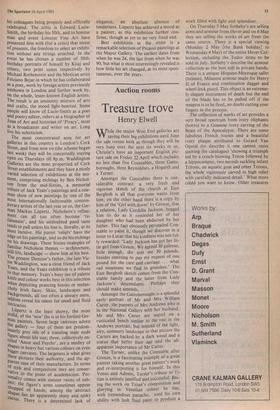Auction rooms
Treasure trove
Henry Elwell
while the major West End galleries are saving their big exhibitions until June the sale rooms look as though they will be very busy over the next six weeks or so. Christie's have an important English pic- ture sale on Friday 22 April which includes no less than five Constables, three Gains- boroughs, three Reynoldses, a Hogarth and a Turner.
Amongst the Constables there is con- siderable contrast: a very fresh and vigorous sketch of the church at East Bergholt is all that everyone wants from him; on the other hand there is a copy by him of the `Girl with doves' by Greuze, that a relation, Lady Cordelia Jackson, begged him to do as it reminded her of her daughter who had been abducted by her father. This fact obviously persuaded Con- stable to paint it, though we discover in a letter to Lucas that his kindness was not ful- ly rewarded: 'Lady Jackson has got her lit- tle girl from Greuze. We agreed 30 guineas, little enough, she sent me 30 pounds, besides omitting to pay my request of one pound for the care and carriage ... what sad meanness we find in grandees.' The East Bergholt sketch comes from the Con- stable family and the latter from Lady Jackson's descendants. Perhaps they should make amends.
Amongst the Gainsboroughs is a splendid early portrait of Mr and Mrs William Carter, the parents of Mrs Andrews who is in the National Gallery with her husband. Mr and Mrs Carter are seated on a rusticated bench similar to the one in the Andrcws portrait, but instead of the light, airy, summery landscape in that picture the Carters are backed by a dark wood and a statue that befits their age and the all- apparent importance of Mr Carter.
The Turner, unlike the Constable after Greuze, is a fascinating example of a great painter taking another great painter's work and re-interpreting it for himself. In this Venus and Adonis, Turner's tribute to Ti- tian is entirely justified and successful. Bas- ing the work on Titian's composition and glorying in Venetian colour he has, with tremendous
Panache, used his own ability with lush fluid paint to produce a work filled with light and splendour.
On Thursday 5 May Sotheby's are selling arms and armour from Hever and on 6 May they are selling the works of art from the same source. There is a special viewing (Monday 2 May [the Bank holiday) to Wednesday 4 May) of the entire Hever Col- lection, including the Tudor items to be sold in July. Sotheby's describe the armour collection as the best still in private hands. There is a unique Hispano-Moresque sallet (helmet), Milanese armour made for Henry II of France and combination dagger and wheel-lock pistol. This object is an extreme- ly elegant instrument of death but the end of the blade has to be pulled off if the weapon is to be fired, no doubt cutting your fingers in the process.
The collection of works of art provides a very broad spectrum from ivory oliphants (horns) to a Goanese ivory carving of the Beast of the Apocalypse. There are some fabulous French ivories and a beautiful ivory plaque attributed to Gerard Van Opstal (to describe it one cannot resist quoting the catalogue) 'showing a triumph led by a conch-blowing Triton followed by a hippocampus, two nereids suckling infant Tritons, an aquatic goat and other Tritons, the whole vigorously carved in high relief with carefully indicated detail.' What more could you want to know. Other treasures are a cameo bust in sapphire of Elizabeth and an enamelled gold pendant containing a bezoar which a previous owner claimed was a gift from Charles V to Pizarro. One wonders if after all he had been through he would have needed it. Finally, for the man who has everything, you can give an arm and a leg for a highly important reliquary containing St Luke's arm bone that once belonged to Ferdinand and Isabella.
Phillips are selling four religious pain- tings that once hung in various Butlins holi- day camps. As we all know, they were discovered recently and apparently they reflect 'the collecting zeal and acumen of the late Sir Billy Butlin', according to Phillips. However, one is tempted to think that as he had four chapels he had to put something in them. He paid £49 for William Dyce's 'Lamentation of the dead Christ' at Christie's in 1947; on 10 May Phillips hope it will make between £85,000 and £100,000.
Looking forward to June, Christie's are having their largest house sale since the war, at Godmersham Park. Jane Austen fre- quently visited when it was her brother Ed- ward Knight's house. It was bought in 1936 by Mr and Mrs Robert Tritton who had plenty of money to buy during the Twenties and Thirties, forming the most important collection of English and French furniture to be sold for many years. The sale takes place on 6, 7, 8 and 9 June. The library con- centrating on Jane Austen and the pictures are to be sold in London in specialist sales through the summer.











































 Previous page
Previous page